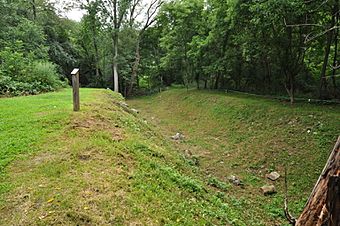Seneca River Crossing Canals Historic District facts for kids
Quick facts for kids |
|
|
Seneca River Crossing Canals Historic District
|
|

A portion of the original 1820s canal ditch
|
|
| Nearest city | Montezuma and Tyre, New York |
|---|---|
| Area | 70 acres (28 ha) |
| Built | 1817 |
| Architect | Richmond, Van Rensselaer |
| NRHP reference No. | 05001397 |
| Added to NRHP | December 09, 2005 |
The Seneca River Crossing Canals Historic District is a special area in Montezuma and Tyre, located in Cayuga and Seneca Counties, New York. It's like an outdoor museum that protects important parts of the historic Erie Canal. This district helps us remember how people used to travel and move goods across New York a long time ago.
This historic district was officially added to the National Register of Historic Places in 2005. This means it's recognized as a very important place in American history.
Contents
What Makes This Place Special?
The Seneca River Crossing Canals Historic District covers more than a mile of old canal structures. It shows how the Erie Canal changed over time. You can see parts of the original canal and also the bigger, "Enlarged" canal.
The Amazing Erie Canal
The Erie Canal was a huge project that changed New York and the United States. It was a man-made waterway that connected the Great Lakes to the Atlantic Ocean. This made it much easier and cheaper to transport goods and people.
Building the First Canal
The very first Erie Canal was built between 1817 and 1825. It was a big challenge to dig this long ditch across New York. In this district, you can still see parts of this original canal.
- Lock #62: Locks are like water elevators that help boats move up or down between different water levels. The remains of Lock #62 from the first canal are here.
- Mule Bridge Piers: Mules used to pull the canal boats from a path next to the water. There were bridges for the mules to cross the river, and you can still see parts of these old bridges.
Making it Bigger: The Enlarged Erie Canal
As more people used the canal, it became too small. So, between 1849 and 1857, the canal was made much wider and deeper. This bigger version was called the Enlarged Erie Canal.
- Canal Prism: This is the main channel where the boats floated. You can see over a mile of this wider canal prism here.
- Towpath and Heelpath: The towpath was the path where mules or horses walked to pull the boats. The heelpath was on the other side of the canal.
- Drydock: A drydock is a special basin where boats can be pulled out of the water for repairs. There's a drydock here that was used for canal boats.
- Richmond Aqueduct: An aqueduct is like a bridge that carries water over another river or valley. The Richmond (Montezuma) Aqueduct carried the canal over the Seneca River. You can still see the remains of this important structure.
- Culvert: A culvert is a tunnel that carries a small stream or ditch under the canal. There's one here that allowed a stream to flow without interfering with the canal.
Images for kids




